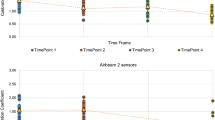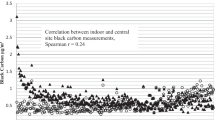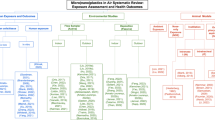Abstract
Personal monitoring studies have indicated that environmental tobacco smoke (ETS) and cooking are major indoor particulate sources in residential and nonindustrial environments. Continuous monitoring of fine particles improves exposure assessment by characterizing the effect of time-varying indoor sources. We evaluated a portable nephelometer as a continuous monitor of indoor particulate levels. Simultaneous sampling with the nephelometer and PM2.5 impactors was undertaken to determine the relationship between particle light scattering extinction coefficient (σsp) and particle mass concentration in field and environmental chamber settings. Chamber studies evaluated nephelometer measurements of ETS and particles produced from toasting bread and frying foods. Field measurements were conducted in 20 restaurants and bars with different smoking restrictions, and in five residential kitchens. Additional measurements compared the nephelometer to a different mass measurement method, a piezobalance, in a well-characterized residence where various foods were cooked and ETS was produced. Since the piezobalance provides 2-min average mass concentration measurements, these comparisons tested the ability of the nephelometer to measure transient particle concentration peaks and decay rate curves. We found that σsp and particle mass were highly correlated (R2 values of 0.63–0.98) over a large concentration range (5–1600 µg/m3) and for different particle sources. Piezobalance and gravimetric comparisons with the nephelometer indicated similar σsp vs. mass slopes (5.6 and 4.7 m2/g for piezobalance and gravimetric comparisons of ETS, respectively). Somewhat different σsp vs. particle mass slopes (1.9–5.6 m2/g) were observed for the different particle sources, reflecting the influence of particle composition on light scattering. However, in similar indoor environments, the relationship between particle light scattering and mass concentration was consistent enough to use independent nephelometer measurements as estimates of short-term mass concentrations. A method to use nephelometer measurements to determine particulate source strengths is derived and an example application is described.
This is a preview of subscription content, access via your institution
Access options
Subscribe to this journal
Receive 6 print issues and online access
$259.00 per year
only $43.17 per issue
Buy this article
- Purchase on Springer Link
- Instant access to full article PDF
Prices may be subject to local taxes which are calculated during checkout
Similar content being viewed by others
Author information
Authors and Affiliations
Corresponding author
Rights and permissions
About this article
Cite this article
BRAUER, M., HIRTLE, R., LANG, B. et al. Assessment of indoor fine aerosol contributions from environmental tobacco smoke and cooking with a portable nephelometer. J Expo Sci Environ Epidemiol 10, 136–144 (2000). https://doi.org/10.1038/sj.jea.7500076
Received:
Accepted:
Published:
Issue Date:
DOI: https://doi.org/10.1038/sj.jea.7500076
Keywords
This article is cited by
-
Attachment rate characteristics of different wide used aerosol sources in indoor air
Journal of Environmental Health Science and Engineering (2021)
-
Participatory testing and reporting in an environmental-justice community of Worcester, Massachusetts: a pilot project
Environmental Health (2010)
-
PM1 and PM2.5 ionic composition and VOCs measurements in two typical apartments in Athens, Greece: investigation of smoking contribution to indoor air concentrations
Environmental Monitoring and Assessment (2010)
-
Incense smoke: clinical, structural and molecular effects on airway disease
Clinical and Molecular Allergy (2008)
-
Evaluation of the recursive model approach for estimating particulate matter infiltration efficiencies using continuous light scattering data
Journal of Exposure Science & Environmental Epidemiology (2007)



